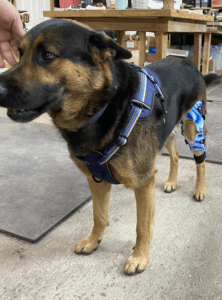Do Knee Braces Really Work For Dogs?
Should Dog Knee Braces Be the First Line of Treatment for CCL Tears?
Dog knee braces have become a go-to solution for pet owners and veterinarians—especially when TPLO surgery isn’t ideal. But what if we flipped the script? Should custom stifle braces be the first line of treatment for a cranial cruciate ligament (CCL) tear, rather than a last resort?
In human medicine, doctors exhaust all non-invasive options before recommending surgery. Treatments like rest, ice, anti-inflammatories, orthotics, and physical therapy come first. Unfortunately, veterinary medicine hasn’t fully embraced this approach. And for good reason—many over-the-counter braces for dogs offer little support, and poorly made custom braces can do more harm than good.
This lack of quality may explain why some veterinarians hesitate to recommend bracing as a primary treatment. However, growing evidence suggests that well-made, properly fitted orthotics can support healing and reduce the need for surgery.
What the Research Says
Several studies in human medicine support the use of orthotics for ligament and tendon repair. For example, a recent article in the British Journal of Sports Medicine reported:
“After management of acute ACL rupture with the CBP, 90% of patients had evidence of healing on 3-month MRI (continuity of the ACL). More ACL healing on 3-month MRI was associated with better outcomes.”
Read the full study
Although research in veterinary medicine is still limited, early findings are promising. Two recent studies highlight the benefits of bracing for dogs with CCL tears:
- Veterinary Evidence Study
This study measured weight-bearing improvements in dogs using custom stifle braces.“TPI% improved significantly by 5.1% in the affected limb when compared to baseline (p = 0.0020).”
Read the study - University of Louisville Study
Researchers used computer modeling to evaluate stifle joint biomechanics.“Stifle joint biomechanics were improved following orthosis implementation… An orthosis may be a viable option to stabilize a CrCL-deficient canine stifle joint.”
Read the study
The Importance of Quality and Fit
These studies emphasize one key point: quality matters. Off-the-shelf soft braces often fail to provide the support needed for healing. Worse, poorly designed braces can cause hair loss, skin irritation, and wounds—leading many veterinarians to dismiss bracing altogether.
Additionally, some human orthotics companies have entered the animal space without fully understanding canine anatomy. This has led to ill-fitting products and poor outcomes.
However, when braces are custom-made by experienced professionals, the results can rival surgical outcomes. In fact, a study published in the Journal of the American Veterinary Medical Association found that:
“85% of respondents in both groups (TPLO surgery and stifle bracing) reported that they would choose the selected treatment again.”
Read the study
Considering the Risks of TPLO Surgery
While TPLO surgery is common, it’s not without risks. A 2018 study from the Flint Animal Cancer Center revealed a concerning link:
“Dogs with a history of TPLO were 40 times as likely to develop proximal tibial osteosarcoma as were dogs with no history of TPLO.”
Read the study
Additionally, we’ve observed a trend of dropped hock joints following TPLO surgery—often requiring a second brace to stabilize the area. This side effect remains under-researched but is worth noting.
Why Specialized Pet Solutions Leads the Way
At Specialized Pet Solutions (formerly Extremity C-Fab), we’ve been building animal orthotics for over 17 years. Our custom dog knee brace stands out with two unique features:
- Achilles Relief Channel
This design cushions the Achilles tendon and keeps the strap on the front of the leg, reducing pressure and preventing further injury. - Patellar Bar
This feature prevents drawer motion—the primary cause of CCL tears—by stabilizing the knee and limiting unwanted movement.
We use the same high-quality materials found in human orthotics, ensuring durability and comfort. With accurate measurements, a solid cast, and strong communication between the client, veterinarian, and our team, we can build a brace that truly helps dogs heal—without surgery.
The Future of Animal Orthotics
The truth is simple: animal orthotics work—when done right. As the industry grows, it’s crucial for companies to stay committed to learning, innovating, and prioritizing the animal’s well-being.
We believe it’s time for veterinarians to consider custom stifle braces as a first-line treatment for CCL tears. With the right tools and expertise, we can offer pets a safer, more affordable path to recovery.


